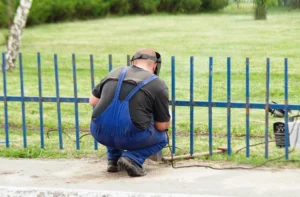In the world of architectural design and home improvement, few elements combine functionality and aesthetics quite like railings.
Whether gracing a grand staircase, securing a balcony, or defining an outdoor space, railings serve as both crucial safety features and striking design elements.
Mastering their installation requires a unique blend of technical expertise, design sensibility, and precise craftsmanship.
The Foundation of Excellence
Planning and Preparation
Success in railing installation begins long before the first bracket is mounted. Proper planning involves several critical considerations:

Beautiful custom railings on the stairs
- Code Compliance
- Height requirements
- Spacing regulations
- Load-bearing specifications
- Material restrictions
- Safety standards
- Site Assessment
- Mounting surface evaluation
- Clearance measurements
- Traffic flow patterns
- Environmental factors
- Existing structural elements
Understanding these fundamentals ensures not only safety compliance but also optimal functionality and longevity of the installation.
Material Selection: Where Form Meets Function
Modern railing systems offer an array of material options, each bringing unique advantages and considerations:
Metal Options
- Wrought Iron: Classic durability with endless design possibilities
- Stainless Steel: Modern appeal with excellent weather resistance
- Aluminum: Lightweight and low maintenance
- Bronze: Elegant patina development over time
Glass Systems
- Tempered Glass: Maximum visibility with superior strength
- Laminated Glass: Added safety with shatter resistance
- Frosted Glass: Privacy without sacrificing light transmission
Wood Varieties
- Hardwoods: Rich appearance with natural durability
- Treated Pine: Cost-effective exterior solutions
- Exotic Woods: Unique grain patterns and coloring
Composite Materials
- Weather-resistant properties
- Low maintenance requirements
- Consistent appearance
- Color stability
Technical Precision in Installation
The installation process demands attention to detail and technical expertise across several key areas:
Mounting Systems
- Surface Mount
- Post plate securing
- Concrete anchor selection
- Proper torque application
- Waterproofing considerations
- Core Mount
- Core drilling precision
- Sleeve Installation
- Grout selection
- Alignment verification
- Side Mount
- Bracket placement
- Load distribution
- Fastener selection
- Surface reinforcement
Component Integration
Successful installations require seamless integration of various components:
- Posts and brackets
- Handrail sections
- Balusters or panels
- End caps and transitions
- Hardware and fasteners
The Art of Precision Fitting
Creating truly seamless railings requires mastery of several specialized techniques:
Custom Fitting
- Precise angle measurements
- Clean joint creation
- Smooth transitions
- Level maintenance
- Plumb alignment
Connection Methods
- Welding Techniques
- TIG welding for stainless steel
- MIG welding for mild steel
- Spot welding for specific applications
- Ground joint finishing
- Mechanical Fastening
- Hidden fastener systems
- Threaded coupling methods
- Compression fittings
- Pin and socket joints
Aesthetic Considerations
The visual appeal of railing systems relies heavily on attention to aesthetic details:
Design Elements
- Clean line maintenance
- Symmetrical spacing
- Consistent reveals
- Pattern alignment
- Surface finish quality
Finishing Touches
- Metal Finishing
- Powder coating application
- Brush finishing techniques
- Polish and patina creation
- Clear coat protection
- Wood Finishing
- Sanding progression
- Stain application
- Sealer selection
- UV protection
Environmental Adaptations
Different environments require specific installation considerations:
Exterior Applications
- Weather resistance measures
- Thermal expansion allowance
- Drainage provisions
- Anti-corrosion treatments
- UV protection systems
Interior Installations
- Climate control effects
- Wear pattern anticipation
- Maintenance accessibility
- Lighting integration
- Sound dampening
Quality Control and Testing
Ensuring long-term safety and satisfaction requires thorough quality control:
Installation Verification
- Load testing procedures
- Alignment checks
- Joint inspection
- Finish examination
- Operation testing
Documentation
- Compliance certificates
- Installation records
- Maintenance schedules
- Warranty information
- User Guidelines
Maintenance and Longevity
Proper installation should facilitate ongoing maintenance and maximize system longevity:
Maintenance Considerations
- Cleaning access
- Part replacement capability
- Finish touch-up methods
- Hardware adjustment
- System monitoring
Long-term Care
- Regular inspection schedules
- Preventive maintenance
- Wear point monitoring
- Finish preservation
- Component updates
Innovation in Railing Systems
The industry continues to evolve with new technologies and techniques:
Modern Innovations
- LED integration systems
- Smart monitoring capabilities
- Advanced materials
- Modular designs
- Custom fabrication methods
Crafting Lasting Excellence
Mastering railing installation requires a comprehensive understanding of both technical requirements and aesthetic principles. Success lies in the careful balance of safety standards, design preferences, and practical considerations. As the industry continues to evolve, staying current with new technologies and techniques while maintaining fundamental installation principles ensures the creation of railing systems that are both beautiful and secure.
The true art of seamless railing installation lies not just in meeting safety standards but in creating systems that enhance their surroundings while providing reliable protection for years to come. Whether working with traditional materials or incorporating cutting-edge innovations, the goal remains the same: to craft railings that combine impeccable safety with timeless style.




